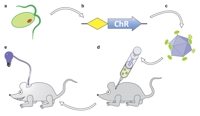
Institute of Biology, Experimental Biophysics, Humboldt Universität Berlin, Invalidenstraße 42, 10115 Berlin, Germany
e-mail: hegemann@rz.hu-berlin.de

 |
Peter Hegemann
Institute of Biology, Experimental Biophysics, Humboldt Universität Berlin, Invalidenstraße 42, 10115 Berlin, Germany e-mail: hegemann@rz.hu-berlin.de |
 |
Channelrhodopsins (ChRs) are directly light-gated ion channels. During the recent years we have studied several wild type ChRs and engineered many variants and hybrids with respect to enhanced or decelerated kinetics, red or blue shifted absorption maxima, and reduced inactivation.[1-3] The greatest challenge was to change the ion selectivity. We improved selectivities in favour of H+, Na+, K+ and Ca2+. I will discuss these features on the basis of a kinetic model that we established in collaboration with Dietrich Gradmann (Göttingen). Based on the recently published 3D-structure [4] we are now able to assign the key amino acids to the "Active Site", "Central gate", "inner Gate" or the "Outer Entrance Channel". I will discuss the problem of how primary retinal isomerization leverages conformational changes of the protein (a process that is still unknown for all microbial rhodopsins) and gates the ion channel.
I will also discuss new concepts for combined approaches in order to make channels of the human brain light sensitive.
At the end I will present a few examples of neuroscience applications (Optogenetics).